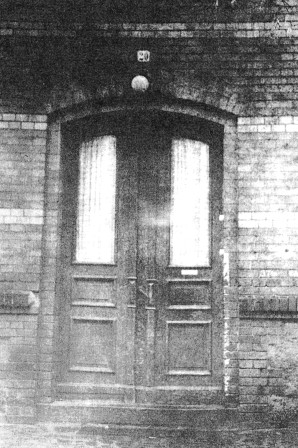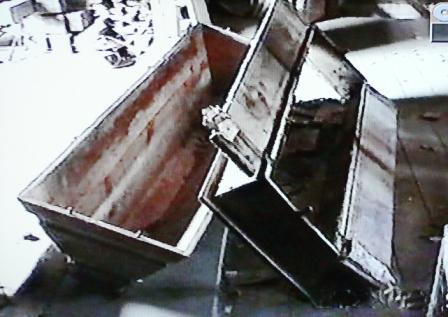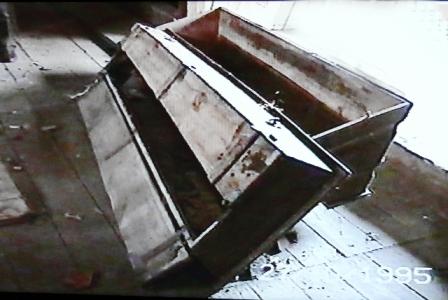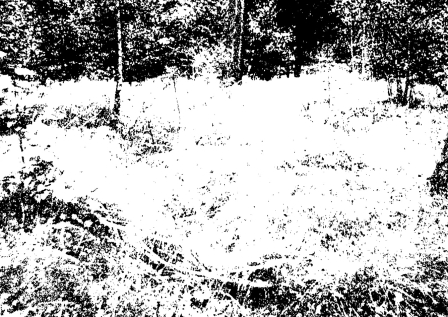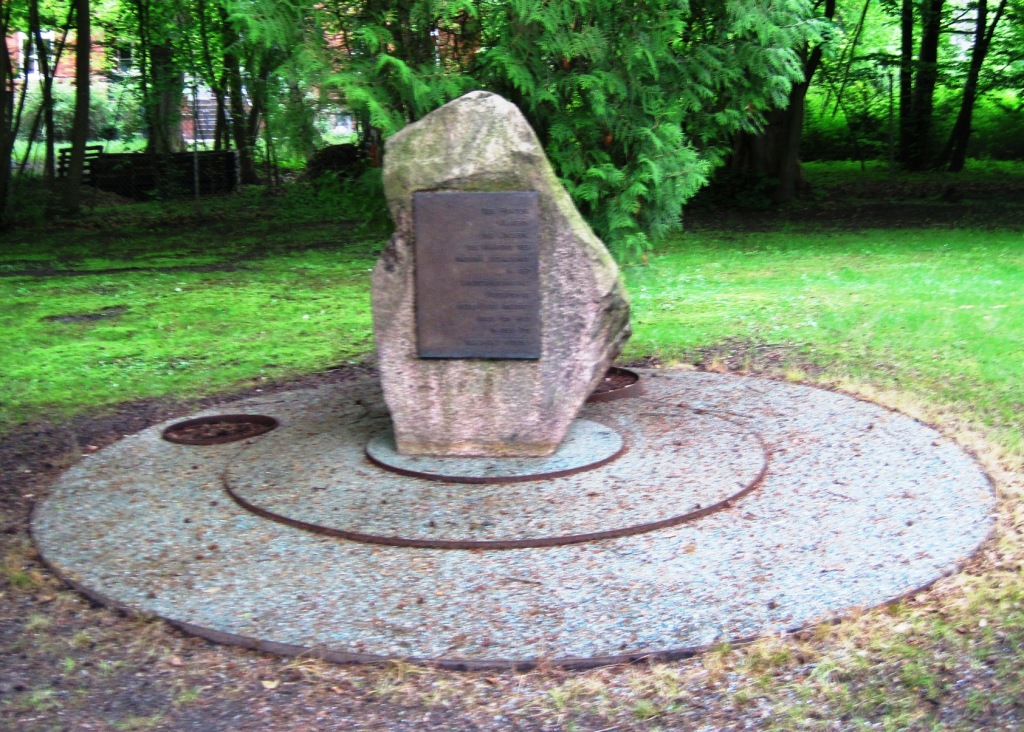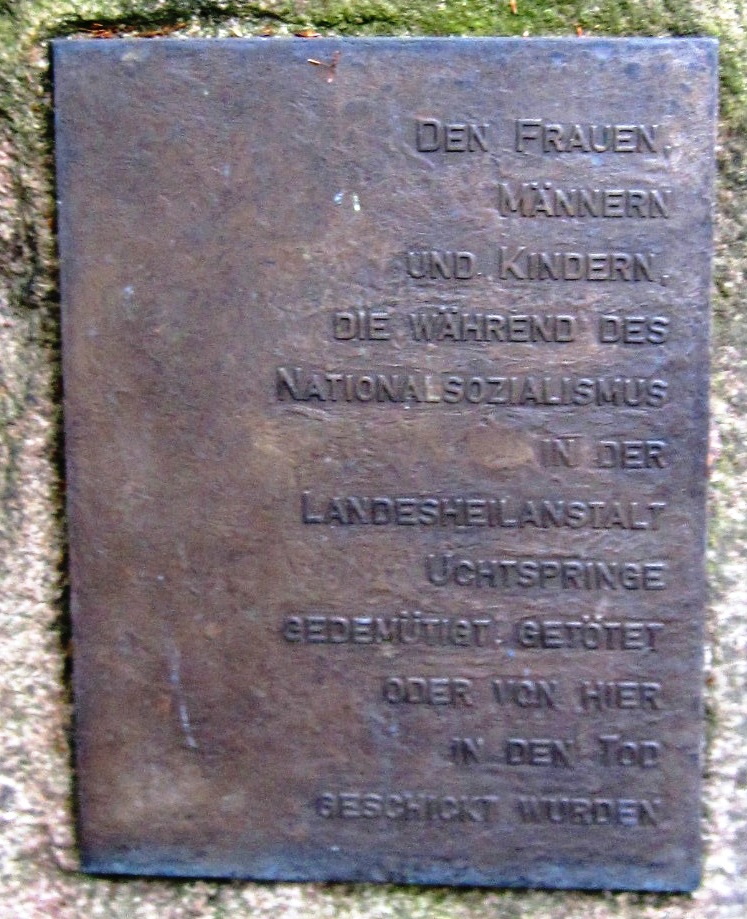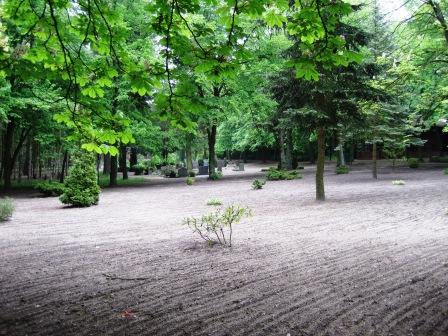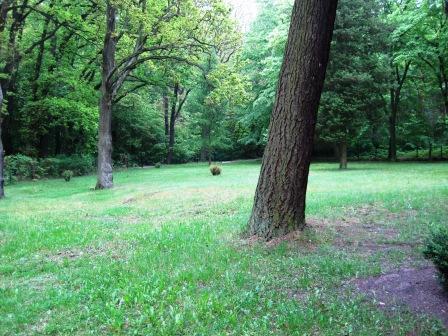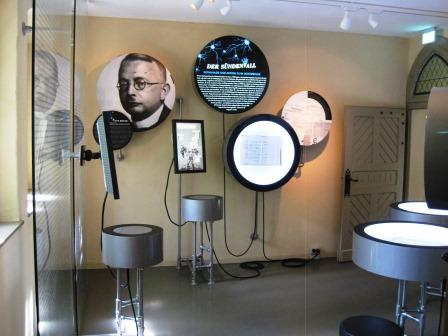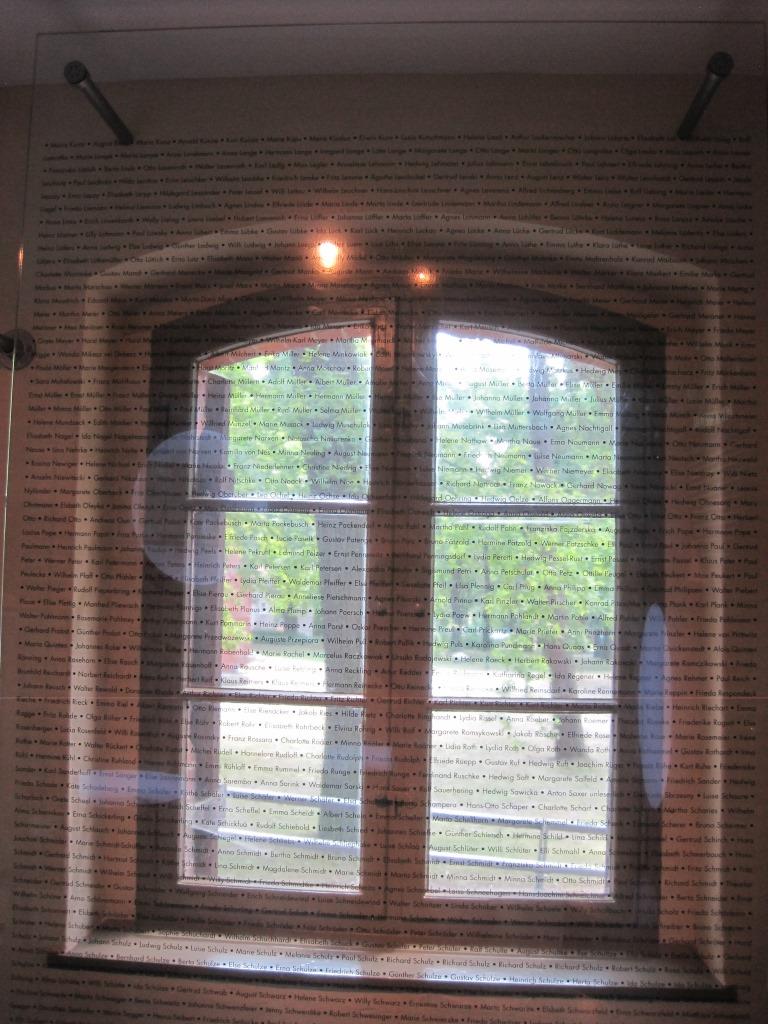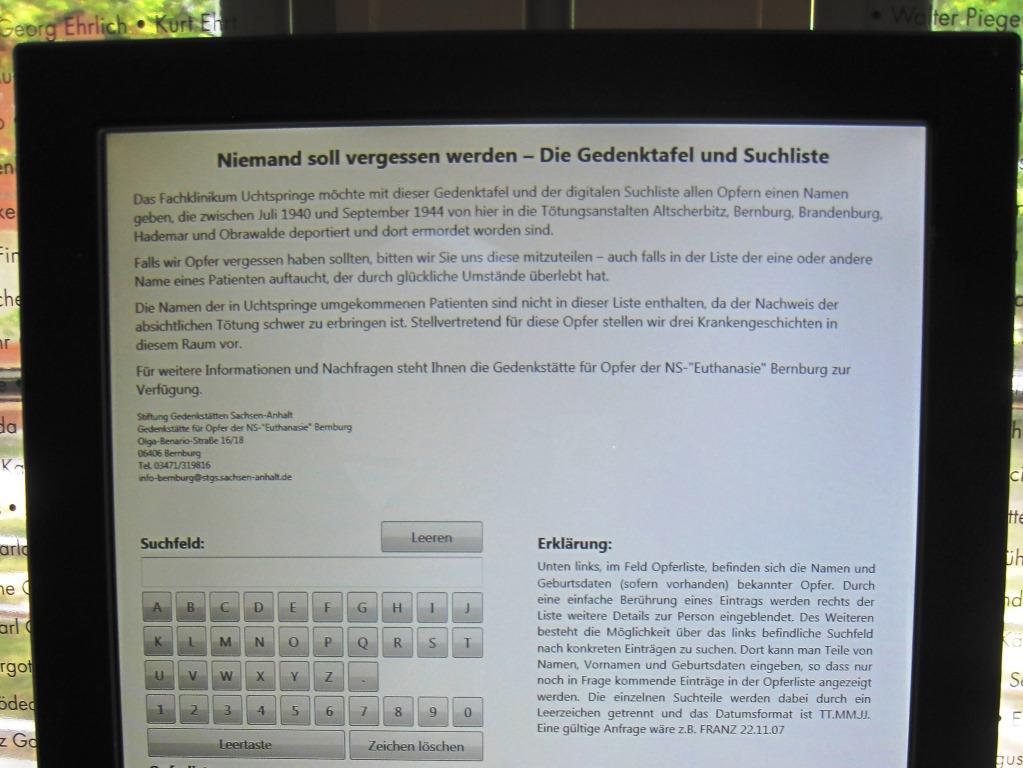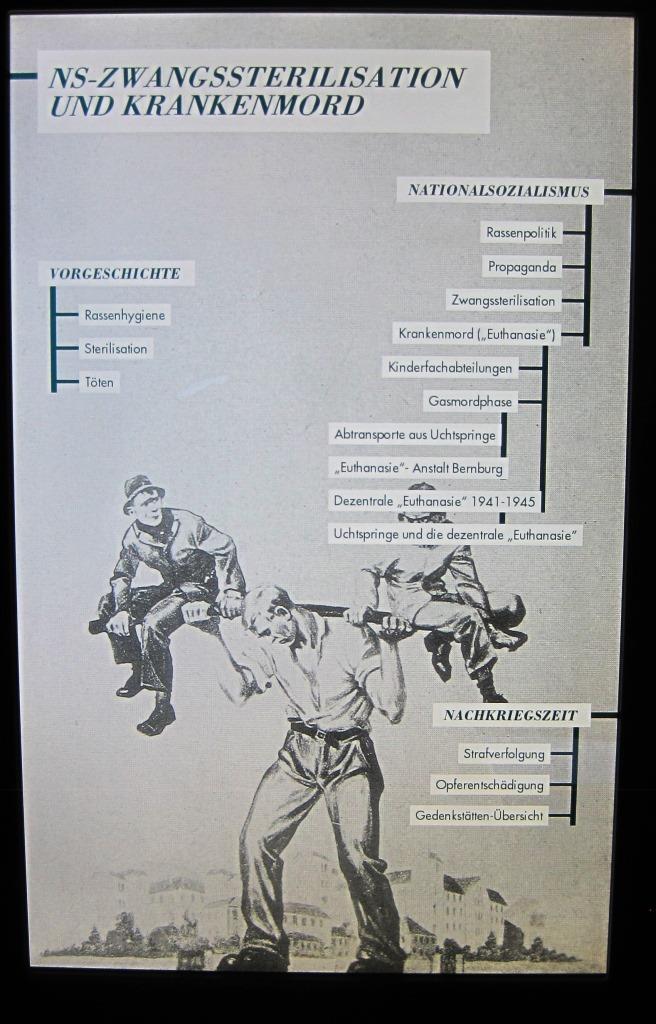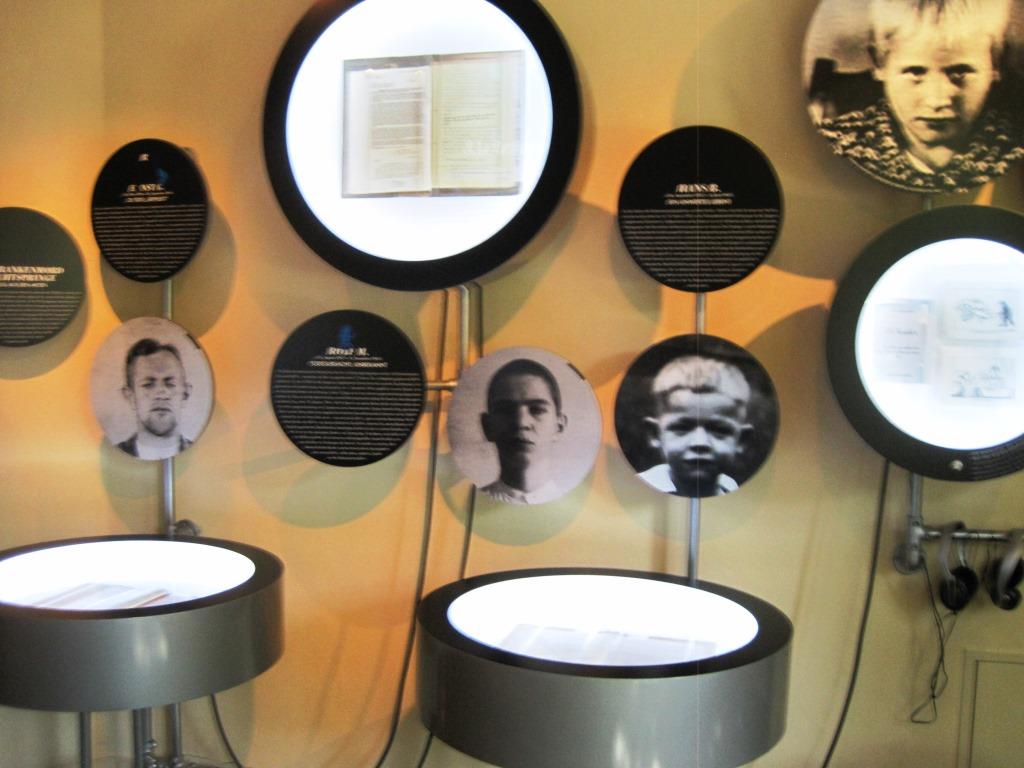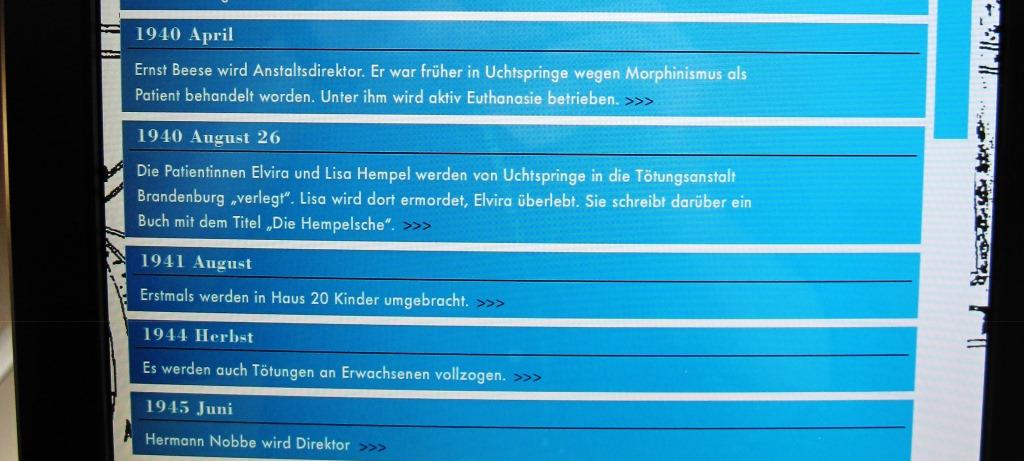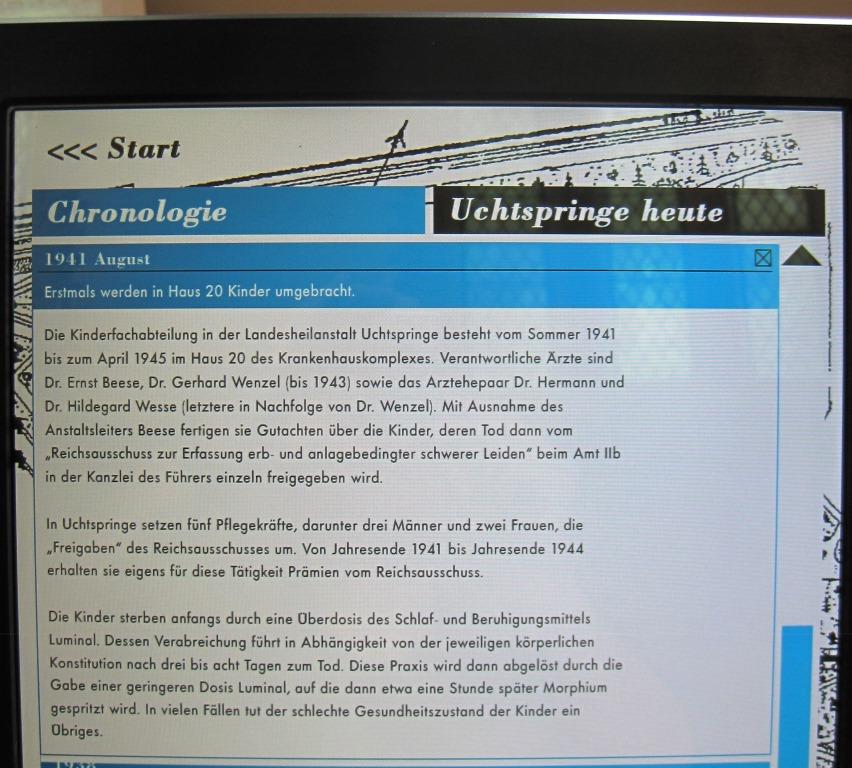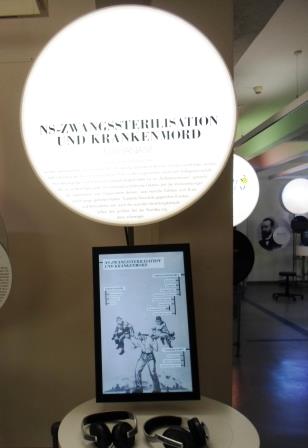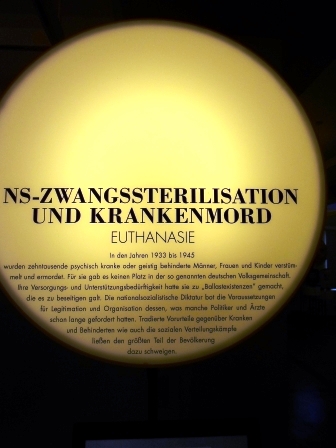Home
Uchtspringe (Landesheilanstalt Uchtspringe)
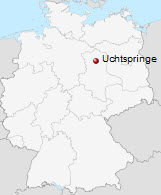
The Kinderfachabteilung in Uchtspringe was established in June 1941 as the
only such ward in what today is the state of Saxony-Anhalt and continued to
operate until April 1945. The clinic's medical director was Dr. Ernst Beese,
and the physicians responsible for the "special children's ward" were Dr.
Gerhard Wenzel from July 1941 to April 1942 and, after a brief absence after
being called up by the German army, from June 1942 to September 1943. He was
succeeded by Hermann Wesse, who had worked in the special children's wards
Görden, Waldniel, and Leipzig before, until he was drafted into the German
army in December 1943 (after his release in April 1944 he then headed the
special children's ward in Kalmenhof). His successor was his wife, Dr.
Hildegard Wesse, who held the position until July 1945 (the American army
had occupied Uchtspringe in April).
Dr. Beese died of a stroke in June 1945. Dr. Wenzel was acquitted in his
trial by the district court (Landgericht) Göttingen in 1953 and worked in a
clinic for people with head trauma. Hermann Wesse became the longest-serving
convicted "euthanasia" doctor after having been convicted to death in atrial
in Frankfurt for his activities at the Kalmenhof
(converted to life in prison) and to life in prison for his activities at Waldniel
in a trial at Düsseldorf. He was released in 1966 for medical reasons. Dr.
Hildegard Wesse was acquitted in the same trial as Dr. Wenzel for her
involvement in killing children but convicted of manslaughter for killing 30
adult women. The sentence was two years in prison but did become final, as
the case was dropped in 1954. After that, Dr. Hildegard Wesse practiced as a
physician in Braunschweig for 30 years and died in 1997 (Klieme 1997, p.
2008).
The number of victims has been estimated to be as follows: about 1,800
victims who were sent to their death as part of "T4," and approximately 500
patients killed in the clinic, the vast majority of whom were children.
Trial records put the number of children murdered with Luminal and morphine
at approximately 350 children and youths, not including those who died of
neglect or starvation (Synder 2001, p. 90), between 1940 and 1945. D. Roer
notes the death of at least 753 children and youths between August 1941 and
April 1945 (Roer 1992, p. 24), and even 809 deaths among those age 20 and
younger between January 1941 and April 1945 (Roer 1997, p. 125). These
numbers are large in comparative perspective, and Uchtspringe, in terms of
its sheer capacity, ranks among the largest next to Görden
and Lüneburg
(Topp 2005, p. 92 n. 482), as well as Konradstein
and Vienna.
Sources: Synder 2001, p. 89; McManama; Klieme 1997, p. 215
The pictures above show the house in which the children's ward was housed, a
drop-bottom coffin for the 'disposal' of the victims, and the overgrown
field of victims' graves in the cemetery in 1989.
Source: author
Research on the victims at Uchtspringe by Kriemhild Synder (a physician
there), Dorothee Roer, and Joachim Klieme in the 1990s ushered in a new
"dealing with the past." An association in support of the clinic
(Förderverein Psychiatrie in Geschichte und Gegenwart e.V.) was founded in
2000, which adopted as one of its tasks the exploration of crimes at the
clinic during National Socialism, helped establish a memorial. On 15
September 2004, the year of the 110th anniversary of the clinic, a memorial
stone for the victims of NS-"euthanasia" was revealed. Its inscription
reads: "To the women, men, and children who were demeaned, killed, or sent
to their death from this place" (Den Frauen, Männern und Kindern, die
während des Nationalsozialismus in der Landesheilanstalt Uchtspringe
gedemütigt, getötet oder von hier in den Tod geschickt wurden). A report of
this event is here (archived). Initially commemorative events
included the placing of a wreath in November.
Source: author
The cemetery, where many of the victims are believed to be buried, is
adjacent to the facility.
The web page of the SALUS
Fachklinikum Uchtspringe (click on Uchtspringe/Fachklinikum) does not
address "euthanasia" on its front pages, although it used to refer to a
paper by Dr. Synder and links to a speech in 2005 of Dr. Volkmar Lischka,
who expressly mentions "children's euthanasia," on its now defunct history
page (history
page; archived). The site www.uchtspringe.de [defunct; archived) has more extensive information, including
Dr. Synder's paper [archived] on "euthanasia" at Uchtspringe and the
establishment of the memorial stone.
One of the children at Uchtspringe was Elvira Manthey. She was reported to
the "T4" and sent to die in the gas chamber of Brandenburg, to follow the
footsteps of her younger sister, but was allowed to turn back. From there
she went to Brandenburg-Görden (itself the
site of a special children's ward) and back to Uchtspringe before she was
released in 1942. Her story is described in a self-published book and here [archived]. A report of her testimony is here, and videos of it is available here: 1, 2, 3.
The exhibit "Psychiatrie im Wandel der Zeit" (Psychiatry as it developed
over time) consists of two principal elements (see the overview here).
The first element is the permanent exhibit housed in the old church on site,
which is now also the visitors' center. The permanent exhibit is entitled
"Vom Gut Modderkuhl zum Fachklinikum - die Geschichte der psychiatrischen
Behandlung in Uchtspringe" (From the estate Modderkuhl to specialized
clinic: the history of psychiatric treatment in Uchtspringe). It addresses
the history of psychiatric care in Germany exemplified by the institution of
Uchtspringe. It includes sections that address changes to the facility's
architecture and how medical-therapeutic views developed over time. Some
parts focus on the impact of some of the clinic directors on the
institutions and the type and quality of care, as well as on the facility
during the German Democratic Republic, and on developments after
reunification. A short film about the history of the institution is
available, as well as an architectural model and a computer terminal with
information.
Source: author.
Included in the permanent exhibit are display panels on "euthanasia" murders
as well as a commemorative wall that contains the names of victims. The
section that addresses this part of the institution's history is called "Der
Sündenfall" (fall into sin). As one enters the room,
on the the left a commemorative wall and a searchable list in an electronic
display panel contain the names of victims who were deported to other
institutions to be murdered there, not those who became victims on site--for
the reason that, as the text notes, deliberate killings would be difficult
to prove. A second electronic display panel contains detailed information
about the "euthanasia" program. It is near-identical to the one displayed at
the exhibit of the memorial Bernburg and in fact was developed by its
director, Dr. Ute Hofmann. Above and to the left of the second electronic
display panel is a portrait of Dr. Beese as well as a text that addresses
his involvement in medical crimes on site. To the right of his portrait is a
text panel that contains the motto of this section of the exhibit and
provides some basic information about the types of medical crimes and
actions that involved Uchtspringe's patient. A large display container below
it addresses compulsory sterilizations on site and shows a booklet with
information about patients' sterilizations. The display to its right shows
administrative and career records for Dr. Beese.
On the opposite wall several more display panels inform about three victims,
one of them a child and one a youth. Also portrayed is the story of Elvira
Manthey, who was sent back from a "T4" transport to Brandenburg/Havel and
then resided in the Uchtspringe institution for some time. An audio station
is also provided.
Source: author
A general computer panel on the history of the institution in the beginning
part of the exhibit provides the most detailed information about "children's
euthanasia" on site.
The exhibit opened on 7 September 2011.
The second element is a traveling exhibit entitled "Dämonen und Neuronen:
Psychiatrie Gestern, Heute und Morgen" (Demons and Neurons: Psychiatry
Yesterday, Today, and Tomorrow), when not on tour, is also housed in the
church. It contains audio- and video-interviews, info terminals and computer
simulations, as well as a variety of panels on the history of psychiatry,
currrent types and manifestations of mental illnesses and disorders, as well
as directions of future development. It is accessible in its entirely online
here: http://salus-institut.de/rundgang/
There is also a flyer.
Source: author
The company id3d
Berlin was responsible for the artistic implementation of the
traveling exhibit commissioned by the Salus Institute. It was curated by beier+wellach
and opened on 18 December 2010.
A 2013 article on the topic of "crimes against children and youths in the NS
period" (Haack and Kumbier 2013) includes short portraits of several
children from the Uchtspringe facility who became victims of "T4" (p. 17).
Most recently, a virtual
tour of the permanent exhibit has become available. A virtual tour of
the travel
exhibit is also available.
The victim Elfriede Blochmann is commemorated here.
Literature
Benzenhöfer, Udo. 2003. "Genese und Struktur der
'NS-Kinder- und Jugendlicheneuthanasie.'" Monatsschrift
für Kinderheilkunde 151: 1012-1019.
Fuchs, Petra, and Maike
Rotzoll. 2006. "Die Selektionskriterien der
nationalsozialistischen 'Euthanasie' am Beispiel der Heil- und
Pflegeanstalt Uchtspringe." Pp. 47-57 in Psychiatrie
des Todes: NS-Zwangssterilisation und "Euthanasie" im Freistaat Anhalt
und in der Provinz Sachsen, Part 2, edited by Ute Hoffmann.
Magdeburg: Landesverwaltungsamt Sachsen-Anhalt.
Haack, Kathleen, and Ekkehardt Kumbier. 2013.
"Verbrechen an Kindern und Jugendlichen in der NS-Zeit." Zeitschrift
für Kinder- und
Jugendpsychiatrie und Psychotherapie 41: 12-19.
Klee, Ernst. 2005. Das Personenlexikon
zum Dritten Reich: Wer war was vor und nach 1945. Frankfurt:
Fischer.
Klieme, Joachim. 1997. Ausgrenzung
aus der NS-"Volksgemeinschaft": Die Neuerkeröder Anstalten in der Zeit
des Nationalsozialismus, 1933-1945. Braunschweig: Selbstverlag
des Braunschweigischen Geschichtsvereins.
Lischka, Volkmar. 2005. "Vortrag
anlässlich der Jubiläumstagung zum 110jährigen Bestehen des
Klinik-Standortes Uchtspringe am 20. Oktober 2005." Available at http://www.salus-lsa.de/portal/index.php?KZ=2979
Manthey, Elvira. 1994. Die
Hempelsche: Das Schicksal eines deutschen Kindes, das 1940 vor der
Gaskammer umkehren durfte. Lübeck: Hempel-Verlag
Heinz Manthey.
McManama, Brigitte. 2010. Chancen
zur Enthospitalisierung und De-Institutionalisierung für Menschen mit
geistigen Behinderungen? Entflechtung der psychiatrischen
Landeskrankenhäuser und deren Folgen für die Behindertenhilfe im Land
Sachsen-Anhalt. Munich: Grin.
Roer, Dorothee. 1992. "Psychiatrie in Deutschland,
1933-1945: Ihr Beitrag zur 'Endlösung der sozialen Frage' am Beispiel der
Heilanstalt Uchtspringe." Psychologie
und Gesellschaftskritik 16(2):15-37.
———. 1997. "'Lebens-unwert': Kinder und Jugendliche in
der NS-Psychiatrie." Pp. 107-30 in Halbierte
Vernunft und Totale Medizin: Zu Grundlagen, Realgeschichte und
Fortwirken der Psychiatrie im Nationalsozialismus, edited by M.
Hamman and H. Asbeck. Frankfurt: Campus.
———. 1998.
"Nationalsozialistischer Alltag am Beispiel der Psychiatrischen Anstalten
Uchtspringe und Kaufbeuren-Irsee." In Medizin
und Gewissen: 50 Jahre nach dem Nürnberger Ärzteprozess (CD-Rom),
edited by S. Kolb and H. Seithe.
Rotzoll, Maike, Richter, Paul, and Petra Fuchs. 2006. "The First National Socialist Extermination Crime:
The T4 Program and Its Victims." International
Journal of Mental Health 35(3):17-29.
Synder, Kriemhild. 1994. "Patientenschicksale 1933 bis 1945 in der
Landesheilanstalt Uchtspringe oder Wie sich erinnern?" Pp. 14-25 in 100
Jahre Landeskrankenhaus Uchtspringe 1894-1994, edited by Volkmar
Lischka, Thomas Dost, and Gerhard Schulz. Uchtspringe: selfpublished.
Available at http://www.uchtspringe.de/synder.htm
———. 2001. "Die Landesanstalt Uchtspringe und ihre Verstrickung in
nationalsozialistische Verbrechen." Pp. 73-95 in Psychiatrie
des Todes: NS-Zwangssterilisation und "Euthanasie" im Freistaat Anhalt und
in der Provinz Sachsen, edited by U. Hoffmann. Magdeburg:
Landeszentrale für politische Bildung Sachsen-Anhalt. Available at http://www.sachsen-anhalt.de/LPSA/fileadmin/Elementbibliothek/Bibliothek_Stiftung_Gedenkstaetten/Bernburg/Psychiatrie_des_Todes_-_Teil_1.pdf
Tögel, Christfried, and Volkmar Lischka, eds. 2005. 'Euthanasie'
und Psychiatrie (Uchtspringer Schriften zur Psychiatrie,
Neurologie, Schlafmedizin, Psychologie und Psychoanalyse). Uchtspringe:
Sigmund-Freud-Zentrum.
Topp, Sascha. 2004. “Der ‘Reichsausschuss zur wissenschaftlichen Erfassung
erb- und anlagebedingter schwerer Leiden’: Zur Organisation der Ermordung
minderjähriger Kranker im Nationalsozialismus 1939-1945.” Pp. 17-54 in Kinder
in der NS-Psychiatrie, edited by Thomas Beddies and Kristina Hübener.
Berlin-Brandenburg: Be.bra Wissenschaft.
———. 2005. "Der 'Reichsausschuß zur wissenschaftlichen
Erfassung erb- und anlagebedingter schwerer Leiden': Die Ermordung
minderjähriger Kranker im Nationalsozialismus 1939-1945." Master's Thesis
in History, University of Berlin.
Concerning "Euthanasia" trial(s)
for this location
Bauer, Fritz et al., eds. 1968-1981. Justiz
und NS-Verbrechen: Sammlung deutscher Strafurteile wegen
nationalsozialistischer Tötungsverbrechen, 1945-1966. Amsterdam:
University Press Amsterdam. Vol. 11, pp. 733ff.
Bryant, Michael S. 2005. Confronting the
"Good Death": Nazi Euthanasia on Trial, 1945-1953. Boulder:
University of Colorado Press. Pp. 203-9.
Freudiger, Kerstin. 2002. Die juristische
Aufarbeitung von NS-Verbrechen. Tübingen: Mohr Siebeck. Pp. 344-50.
Mildt, Dick de. In the Name of the
People: Perpetrators of Genocide in the Reflection of Their Post-War
Prosecution in West Germany: The 'Euthanasia' and 'Aktion Reinhard' Trial
Cases. The Hague: Martinus Nuhoff Publishers. Pp. 132-40.
Rüter, Christiaan F. 2002-. DDR-Justiz
und NS-Verbrechen. Sammlung ostdeutscher Strafurteile wegen
nationalsozialistischer Tötungsverbrechen. Amsterdam: University
Press Amsterdam. Vol. 6, pp. 629ff; Vol. 11, pp. 627ff.
Last updated on 13 September 2015
